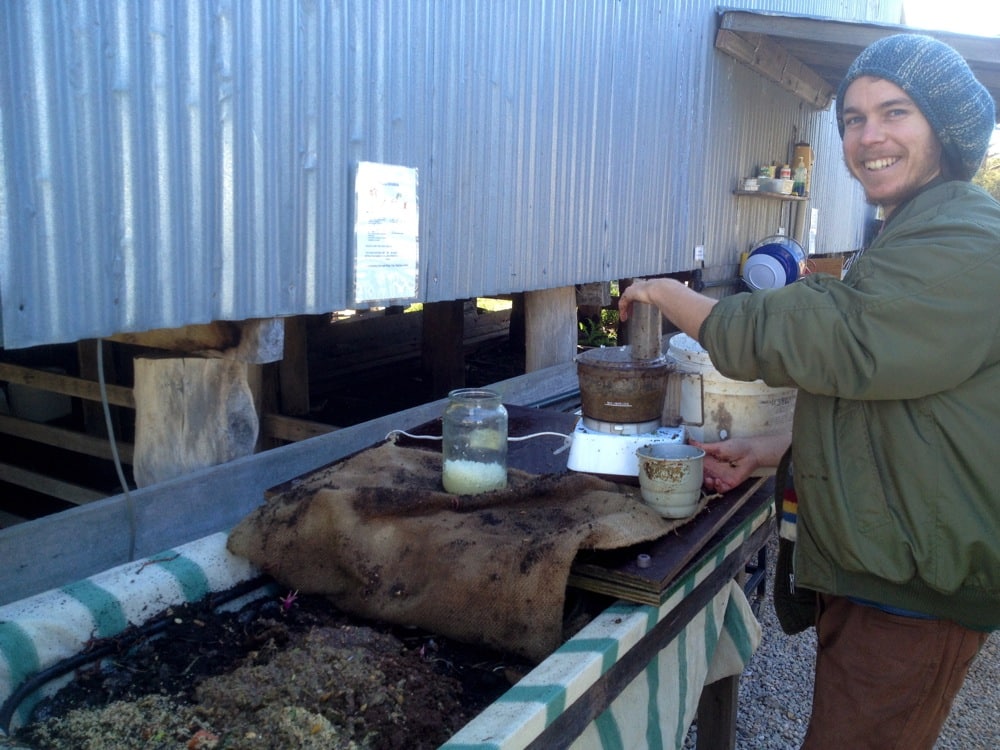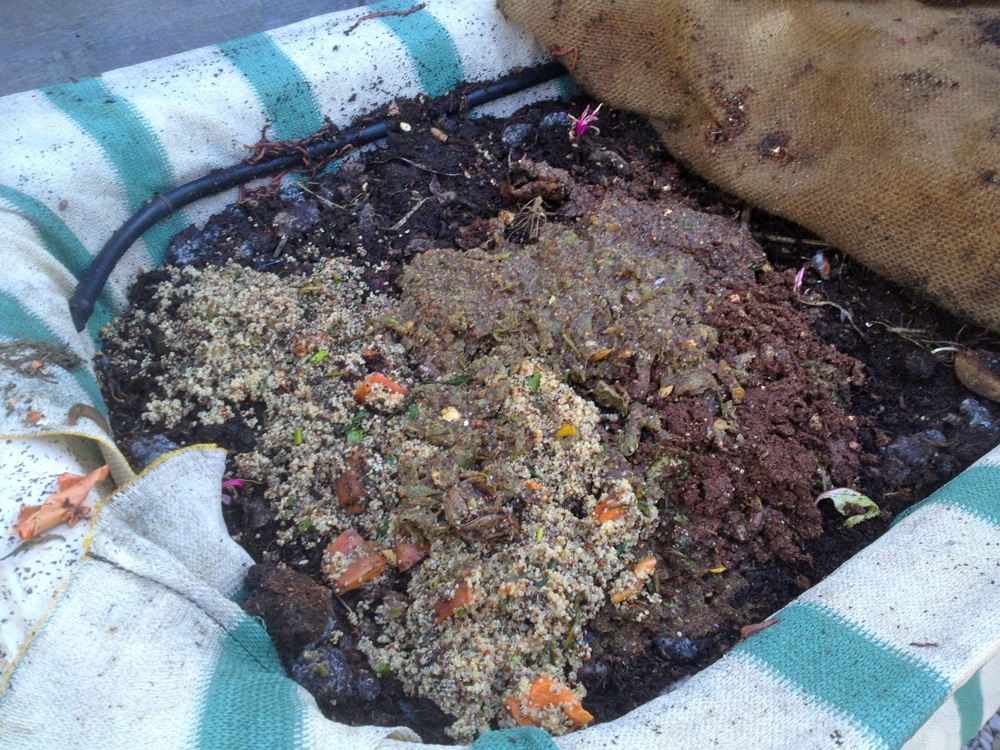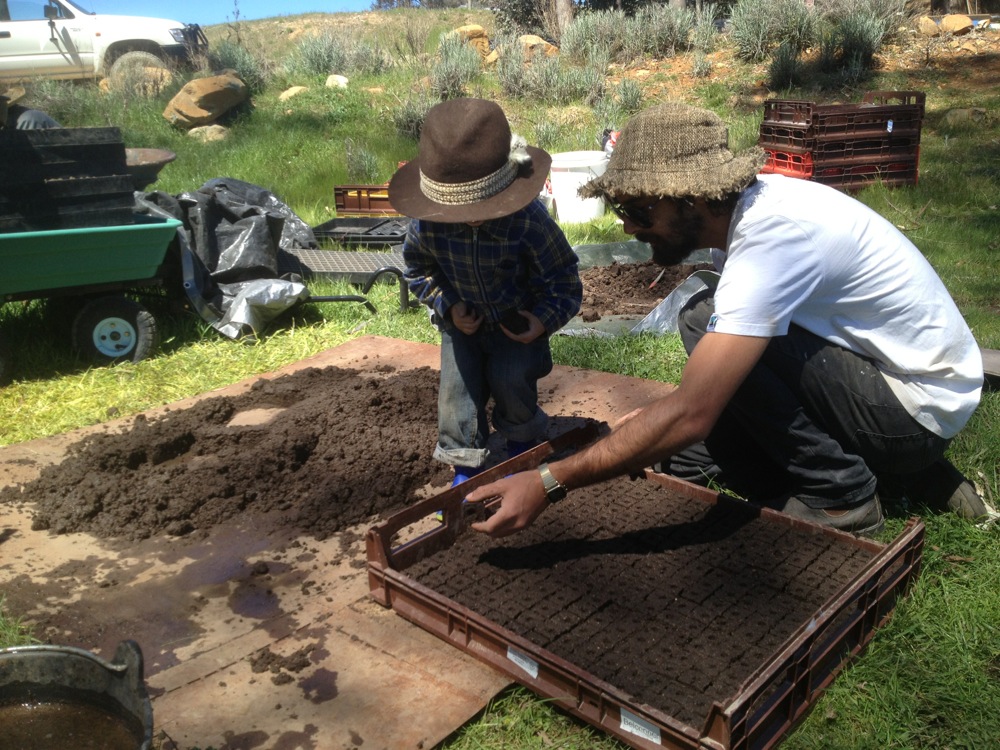While worm farms are pretty normal to find nowadays in many yards, their capacity to cycle essential nutrients and make nutrient dense soil additives available to you, for free, can’t be understated. Worm farms rock, seriously.
Our bathtub wormfarm next to the kitchen garden, with it’s built in vertigation (direct worm juice injection into the irrigation system for the veggie beds), has been going strong for a couple of years now. However Michael needs lots of worm castings (worm poo) as an ingredient for his soil block mix for seedlings, so we’re souping up production.

Worm farm vertigation setup for irrigating veggie beds with diluted worm juice – click on image for the full article on how and why
In short, we need the worms to work overtime, and produce worm castings as fast as they can. The best way to do this is to deliver their food in munch-ready form, so we’ve started blending a bucket of kitchen scraps (veggies only, no meat or dairy) every other day to work to the worm farm.
Adding scraps as a slurpy mush of brassica leaves, potato ends and beans for the back of the fridge, means the worms can get right down to ingesting the food faster. Which means in turn that they cycle the nutrients in those scraps quicker (witht he addition of the bacteria in their gut as the food passes through), and produce more worm castings more quickerer.
And more quickerer is what we’re after. In an intensive, beyond organic vegetable growing system, worm casts and worm juice are gold. They represent nutrients in a soluble form that the veggies can slurp up and turn into leaves and fruit.
And since we’re harvesting nutrient (in the form of yummy veggies) from the garden nearly every day now, that means we have to put a heap of good nutrients back into the garden regularly, to avoid nutrient depletion and to keep the system stable and growing.
Worm casts are also a part of our current soil block mix, which we use for starting off various types of crops. Worm casts are sticky, and the consistency of a soil block needs to be just right to hold the mix together. Stickiness is good. Especially when combined with nutrient.
Our plan later this season is to set up more worm farms and to escalate production, to make more worm casts available. If we can design it right, this might become part of a black soldier fly larvae system (to provide high-protein feed for the chooks), as black soldier fly larvae poo is, in turn, great worm food, which doesn’t need to be blended in order to be assimilated into the worms quickly.
Will it Blend? Well we don’t have a fancy blender in this first stage of the system, but we do have an old kitchen wizz that my mum thoughtfully found at an op shop for me, and which Michael has now commandeered for worm casting production. The worms are rocketing through their food, so yes, it does blend. For now.
Hopefully in the future we can figure a way to remove the powered blender from the equation (bicycle powered blender, perhaps?), but that needs a big farm hack brainstorming session. Maybe next week….





















I have this little system going where everything goes to the chooks, they scratch around, poo and do their thing and then after a couple of months I collect it all and chuck it through our chipper. This goes to the worms and they munch away … No big chunks of anything … Seems to be working well … Much better than just feeding them stuff straight from the kitchen scrap bin.
Nice one Sonja! We also have a chook-scrap system, but it’s over the hill from this system – all about efficient use of energy, eh? 😉
and no citrus or onions 🙂
I can’t believe I never thought about using the kitchen blender instead of using scissors… Such a good idea!
We also add egg shells for calcium and acidity control.
This idea will definitely help the worms going quicker through them!
I love my worls 🙂
My Dad does the same thing. He had an old blender lying around and now blends up veg scraps before adding them to the worm farm. Prior to that, he had an old metal hand crank mincer thing (not sure exactly what it was, it had belonged to my Nana). It mushed things up well, but needed a far bit of arm and hand strength. My Mum doesn’t have much strength in her arms these days due to a nasty fall a couple of years ago so Dad got the blender to make it easier for her to use as… Read more »
If you need castings faster, I’ve found freezing those scraps before feeding the worms gains nearly a third between feedings! it breaks vegetable cell walls very effectively, and stops ‘pongy’ kitchen scrap issues – i’d reckon you’d generate a heap of kitchen waste like we do.. just make sure you thaw the scraps first…
love that worm juice siphon!
Wow, your veges should jump out of the ground with the worm casts your creating here Kirsten. I heard lately from our organic inspector that hessian bags from overseas are riddled with pesticides so we stopped using them for our spuds. Maybe not a good thing for a worm farm cover either. Sorry to be bearer of bad news but you would want to know I thought. Best wishes, Bee
It seems a recurrent theme and makes sense in terms of a worm’s mouth and common experience – the worms don’t feed on food scraps, they feed on the product of whatever makes them finally worm-ready. I have had great success with recent layering of scraps with cow manure and whole bunches of beach cast weaweed (posts: http://foragersyear.wordpress.com/2012/07/14/kelp-ecklonia-radiata-on-groomed-beaches-compost-ahead-of-waste/ and http://foragersyear.wordpress.com/2012/10/09/foraging-for-cow-bos-taurus-manure-the-worm-farm-turbo-charger/). It is such a wonderful game of bio-alchemy; things that make for happy worms, but more importantly supercharged worm-product. You guys are in Sydney enough to pop down for a bucket or two of kelp, go on, why don’tcha? Or,… Read more »
love the worm irrigation setup – such a good idea.. What’s the name of the tool Zag is using to make soil blocks?
A soil blocker! No really 🙂 – see the article on our site
You need a hand crank blender like this one http://www.peddlerswagon.com/p-74-vortex-hand-crank-blender.aspx
Reblogged this on X_trous Notes.
I love your website! I’ve been growing Black soldier fly compost for 11 years in Darwin. I think they are wonderful. So fast & requiring so little of my energy. Maybe my observations will be helpful. I’m so impressed by their speed. Late Dry season ( not humid) I tossed a dead mouse on my tiny compost pile – size of a heaped dinner plate. 8 hours later, when I was considering playing a mouse joke on my friend, all I found was a writhing mouse skin, no bones, no skull left, with full sized larvae jostling beneath it. That… Read more »
Wow thanks for all those insights Anne 🙂
Sorry, I didn’t link my previous post to worm farming.
Would it be possible to design a system that breaks down the chunks of food /cane toads, etc, using soldier flies instead of a blender. This is like take-away for worms. I haven’t ever tried feeding it to worms. Do they really like it?
Yep that would be the ultimate 🙂 we just have to get the BSF system going
I have used an old hand mincer & it seems to work. takes a bit of effort for some of the harder veges
Has the poison in the cane toads killed the worms? I’m trying composting cane toads in a hot compost, then feeding that to worms. Just wondering if there could be an issue for the worms.
After making a green smoothie I blend up all the veg scraps with water- worms love it and it cleans out the blender too. Saw a smoothie bike on the weekend that was imported from the states but I think it wouldn’t be powerful enough to do anything other than fruit. Maybe you can create a different attachment for the clay seed ball maker 🙂